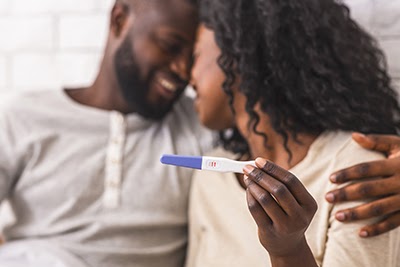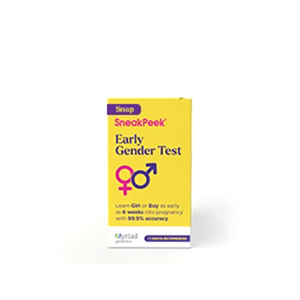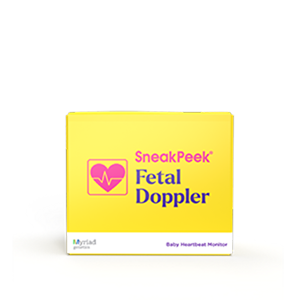Published on November 28th, 2021 and Updated on January 12th, 2024
With the SneakPeek At-Home Early Gender Predictor Test, you can learn the sex of your baby as early as 6 weeks along in your pregnancy.
For many women, the transition from your 20s to 30s can feel like a metamorphosis in many ways. One prominent change is that getting pregnant may go from something you’re desperately trying to avoid to something you’re really trying to do.
While your mind may now be ready to board the baby-making train, your body has already been waiting at the station for quite some time (ever since you got your period, to be exact). In fact, women in their 20s are about twice as likely to conceive as women in their 30s.
The good news is you can boost your fertility and get that baby train on track with a few sensible lifestyle changes—ones that will yield sustainable benefits to you, your partner, and your family in the long term. In this guide, we’ll cover the top 5 ways to boost fertility in your 30s and get you well on your way to a healthy pregnancy.
#1: Get to Know Your Cycle
When you’re trying to conceive, it’s tempting to incorporate the latest fertility trends into your lifestyle. However, the single most effective strategy for boosting fertility in your 30s is this: start getting intimate.
No, not with your partner (that part comes later). We’re talking about getting intimate with your unique reproductive cycle. Specifically, your period.
Think of your period as a finely tuned metronome. In your 20s, it could easily get thrown off-tempo depending on:
- Lifestyle – Smoking and excessive drinking are two things that can cause irregular periods.
- Birth control – Many women start some type of contraception in their late teens or early 20s.
- Stress – Whether it’s graduating from college or trying to find your first job, stress in your 20s is very real.
Plus, in your 20s, it’s not uncommon for ovulation to be irregular, which can make periods irregular as well.
By the 30s, many women find that menstrual cycles keep a relatively consistent tempo, so it’s important to reacquaint yourself with your body’s unique rhythms once you’re in this new phase in life.
If you aren’t already, get in the habit of keeping a record of your period. There are a couple different ways to do this:
- Mark the days you menstruate on a paper calendar
- Keep track of the dates in a planner
- Use a period tracking app, such as Clue or Flo
Keeping track of your menstrual cycle will provide insight into your ovulation window—the period of time when you’re most fertile and most likely to conceive (i.e. your new date nights). If your period follows the average 28-day cycle, ovulation will likely occur roughly 14 days before the start of your next period. If your cycle isn’t exactly 28 days, you can still predict your ovulation window by determining the midpoint of your cycle, as ovulation often occurs in the 4 days before or after the midpoint. To help detect ovulation (the ideal time to get pregnant), pay attention to your cervical mucus as it can give you insight into where you are in your cycle.
While these calculations can be done by hand, a period tracking app can simplify the process and predict your fertile days for you. This way, you can be sure to get busy during your ovulation window, boosting your chances of successfully conceiving.
#2: Revise Your Diet
Nutrition is a decisive factor in both female and male fertility, and a growing bank of research suggests that certain dietary habits can impair or enhance your ability to conceive. Many people may think taking a prenatal vitamin is the only way to help them get pregnant, but there’s so much more you can adjust in your diet to help you reach that healthy pregnancy you dream of!
Let’s review a few key nutrients that play a dynamic role in increasing your fertility.
Folate
Folate is a star mineral in the world of fertility research. One study found that women who took a prenatal multivitamin with 400-800mcg of folic acid for 3 months were 26% more likely to conceive than women who took a placebo pill. This is thought to be due to folate’s instrumentality in aiding cell division, which is elemental to the very earliest stages of conception.
In addition to supplements, you can also incorporate folate into your diet by eating plenty of:
- Asparagus
- Avocado
- Black-eyed peas
- Broccoli
- Brussels sprouts
- Spinach
- White rice
In men, folate may play a role in enhancing sperm count, motility, and quality when coupled with zinc. So go ahead and get into a folate frenzy with your partner. Your future baby will thank you for it.
Polyunsaturated Fats
Fats are an essential macronutrient for fortifying physical health, and the type of fat you’re consuming may have significant bearing on your fertility.
Saturated fats, like those found in butter, pork, and red meat, have been shown to impede male fertility by diminishing semen concentration, but polyunsaturated fats, on the other hand, have the opposite effect. In a trial study, men who routinely consumed polyunsaturated fats (also referred to as essential fatty acids) demonstrated enhanced sperm fitness, while women who upped their intake were more likely to conceive than the control group.
There are 3 main types of polyunsaturated fats you can increase while trying to boost your fertility:
- Omega-3s, found in foods like flaxseed, wild salmon, sardines, and chia seeds.
- Omega-6s, found in foods like walnuts, tofu, and hemp seeds.
- Linoleic acid, found in foods like safflower oil, sunflower seeds, and pine nuts.
Your next date night menu is looking pretty tasty.
Dairy
For a while, it was suspected that consumption of dairy may have a negative effect on female fertility, but the most current research shows no causal connection between the amount of dairy in a women’s diet and a decline in fertility.
That said, evidence suggests that full-fat milk, yogurts, and cheeses may be better for ovulatory function than their skim or low-fat counterparts. If you’re trying to get pregnant, now may be the time to change your zero fat yogurt to it’s full fat twin! now may be the time to switch your Starbucks order from skim to whole milk latte.
#3: Watch Out for Environmental Toxins
When it comes to fertility, the substances we surround our bodies with are just as important as the ones we consume in the form of food. Many household products like plastic bottles, detergents, and cosmetics are formulated with endocrine-disruptors—agents that cause reproductive rhythms to go awry by mimicking or impeding the brain’s steroid receptors. This, in turn, impedes normal hormonal activity and can eventually lead to fertility issues.
There are three chief offenders to look out for when you’re trying to get pregnant with a healthy baby.
Plasticizers
Plastic owes its flexibility to phthalate esters—a chemical lightweight enough to leech into the bloodstream, throw our endocrine system out of whack, and cause fertility declines in men and women alike.
While phthalate esters sound like something not of this world, it actually makes its way into many of the products we use daily, such as:
- Makeup products
- Detergents
- Sunscreens
- Soaps
- Toothpaste
Bisphenol-A, or BPA, is another ubiquitous chemical plasticizer most commonly found in plastic bottles and tin food cans. At the prenatal stage, BPA can inhibit the healthy functioning of your uterus, cause ovarian dysfunction or cyst growth, and interfere with communication between your brain and reproductive organs during the follicular phase of your cycle (i.e. when your body prepares to release an egg).
BPA is particularly dangerous because even low concentrations can have a detrimental effect on endocrine functioning and fertility. To avoid BPA and phthalate esters:
- Reduce your use of plastics – Instead, opt for materials like glass, wood, or ceramic. If you do need to use plastic, avoid applying heat whenever possible. BPA can leak into foods under warmer temperatures, so that means no Tupperware in the microwave.
- Skip canned foods – See if the same food products are available in glass containers instead.
- Read product labels – Manufacturers are required to disclose the presence of phthalate esters in their products, so be sure to check the labels of your makeup, laundry detergent, toothpaste, and other personal care products. Phthalate esters may be listed as phthalates, added fragrance, or any of the following acronyms: DEP, DMP, DBP, DINP, DNOP, or BBP.
Yes, plastics are ubiquitous, and you’d be hard-pressed to eliminate them completely from your life, but even small changes to your routine can have a positive effect on your fertility and overall health.
Pesticides
Pesticides are often used to prevent pests, bacteria, and rodents from damaging crops. However, the chemicals found in pesticides are another cause of diminished reproductive functioning in both men and women.
To limit your exposure to these pesky pesticides, try the following:
- Purchase organic produce – The pesticides used in organic farming are derived from natural sources, rather than synthetic ones. For a more affordable option, choose frozen organic fruits and veggies, which are just as delicious as their fresh counterparts (and a tasty addition to smoothies).
- Avoid high-pesticide produce – Research shows that certain fruits and vegetables contain more pesticide debris than others. These include:
- Apples
- Grapes
- Strawberries
- Tomatoes
- Kale
- Green peppers
- Thoroughly wash your produce – Thoroughly rinsing your produce with water can help remove pesticide residue.
Mercury
Mercury is a chemical that can be noxious to humans when it accumulates in the body. While research into its specific actions is ongoing, one study demonstrated a direct correlation between subjects’ high blood mercury levels and resultant infertility and lead to lower sperm quality and other sperm abnormalities.
Fertility issues from mercury are only one of the dangers in pregnancy. If a pregnant woman is exposed to too much mercury, it can also lead to pregnancy complications, possible birth defects, and jeopardize having a healthy pregnancy.
Humans’ exposure to mercury is largely a result of seafood intake. Some types of seafood present higher quantities of the chemical than others, including:
- Marlin
- Tuna
- Swordfish
- Shark
The takeaway: limit your seafood intake while you’re trying to conceive (aside from that Omega-3 packed wild salmon, which the FDA recognizes as a low-mercury seafood option). After all, you’ve got bigger fish to fry.
#4: Take a Break from Alcohol
Research into how alcohol affects human fertility is ongoing, but we do have a few clues as to why skipping happy hour is advisable while you’re trying to conceive:
- In women, high alcohol intake over a prolonged period can deplete your cache of oocytes, which later become your eggs, housed in your ovaries.
- For men, excessive drinking interferes with the pituitary gland’s release of gonadotropins—hormones that stimulate sperm count and production. It can also lead to decreased testosterone.
- In severe cases, heavy drinking can wreak havoc on the liver, rendering it unable to metabolize hormones involved with regular, healthy reproductive function.
More peer-reviewed research into how moderate drinking affects fertility is still needed, but current evidence suggests that women who don’t drink have a higher likelihood of conceiving than women who have even 1 to 5 drinks a week. So, if alcohol figures prominently into your social life, it may be worthwhile to take a breather from booze and toast to the weekend with a mocktail for the time being.
#5: Pursue a Low-Stress Lifestyle
Stress has damaging physical, mental, and emotional effects on the body, so it should come as no surprise that mitigating anxiety can be enormously helpful for boosting fertility.
In fact, researchers suspect that stress’s negative effects on fertility are hardwired into our makeup, involving a conflict between two brain-body axes:
- The HPG axis – The hypothalamic-pituitary-gonadal axis, in charge of managing reproductive activity and immune function.
- The HPA axis – The hypothalamic-pituitary-adrenal axis, responsible for dealing with stress and maintaining homeostasis, metabolism, and neuropsychiatric function.
When your hypothalamus is tied up with managing real or perceived stress responses, your HPA axis is put in charge of running the show, while your HPG axis falls offline. This means in periods of prolonged stress, a host of reproductive abnormalities can arise, from menstrual dysregulation to lower sperm count.
So now may be the time to finally try out that meditation app you downloaded last year. Other ways to reduce stress include:
- Take daily walks
- Try some deep breathing exercises
- Listen to relaxing music
- Take a warm bath
- Book a massage
Boost Fertility and Make Mindful Choices with SneakPeek
When it comes to giving your fertility a boost, centering your physical and mental health is paramount, and developing mindfulness around the choices you make is key. Even seemingly minor changes can have a major impact when it comes to conceiving and starting your pregnancy journey.
Once your baby train is chugging along, SneakPeek can help you take the same mindful approach to your pregnancy and learn more about the little miracle growing inside of you. With the SneakPeek At-Home Early Gender Predictor Test, you can learn the sex of your baby as early as 7 weeks along in your pregnancy. Not only is the SneakPeek test trusted by over 1 million moms, but it’s also the #1 OBGYN-recommended at-home gender test.
Make your 30s truly unforgettable by taking steps to boost your fertility and choosing SneakPeek.
This post has been reviewed for accuracy by the following medical professional:
Dr. Heather Soper, Certified Nurse Midwife
Dr. Heather Soper brings over 15 years of experience in women's health and obstetrics to her role as the owner of The Genesis Resort for Birth. Complementing her clinical practice, she serves as an Assistant Professor of Nursing at James Madison University, where she educates nursing students with a focus on compassionate, patient-centered care. Her advanced training and dedication to midwifery are evident in her contribution to both academia and the wellness of expectant mothers
Sources:
- US National Library of Medicine. The Influence of Diet on Fertility and the Implications for Public Health Nutrition in the United States. https://www.ncbi.nlm.nih.gov/pmc/articles/PMC6079277/
- VeryWell Family. The Importance of Folic Acid in Female and Male Fertility. https://www.verywellfamily.com/folic-acid-for-female-and-male-fertility-1959878
- National Library of Medicine. Effects of folic acid and zinc sulfate on male factor subfertility: a double-blind, randomized, placebo-controlled trial. https://pubmed.ncbi.nlm.nih.gov/11872201/
- National Library of Medicine. Bisphenol A: an emerging threat to female fertility. https://pubmed.ncbi.nlm.nih.gov/32171313/
- Safer Chemicals, Healthy Families. 10 tips to help reduce your exposure to BPA. https://saferchemicals.org/2014/07/10/10-tips-to-help-reduce-1-2/
- BC Medical Journal. Optimizing fertility Part 2: Environmental toxins. https://bcmj.org/articles/optimizing-fertility-part-2-environmental-toxins
- National Library of Medicine. Alcohol and fertility: how much is too much? https://www.ncbi.nlm.nih.gov/pmc/articles/PMC5504800/
- National Library of Medicine. Does moderate alcohol consumption affect fertility? Follow up study among couples planning first pregnancyhttps://pubmed.ncbi.nlm.nih.gov/9712595/
- National Library of Medicine. The Hypothalamic-Pituitary-Adrenal Axis: A Brief History.https://pubmed.ncbi.nlm.nih.gov/29719288/
- Mayo Clinic. What ovulation signs can I look out for if I’m hoping to conceive? https://www.mayoclinic.org/healthy-lifestyle/getting-pregnant/expert-answers/ovulation-signs/faq-20058000#:~:text=In%20an%20average%2028%2Dday,midpoint%20of%20the%20menstrual%20cycle.
- U.S. Food & Drug Administration. Advice about Eating Fish. https://www.fda.gov/food/consumers/advice-about-eating-fish

Shop Our Products
SneakPeek aims to provide the most accurate and up-to-date information to help our readers make informed decisions regarding their health before, during, and after pregnancy. This article was written based upon trusted scientific research studies and/or articles. Credible information sources for this article are cited and hyperlinked.






